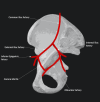Life-Threatening Bleeding Following a Stable Fracture of the Superior Pubic Ramus: A Case Report
- PMID: 38957245
- PMCID: PMC11218421
- DOI: 10.7759/cureus.61520
Life-Threatening Bleeding Following a Stable Fracture of the Superior Pubic Ramus: A Case Report
Abstract
Corona mortis, an anatomical variant documented in the literature, presents a noteworthy concern due to its proximity to the superior pubic ramus. Consequently, it remains susceptible to injury, even in stable, benign fractures of the pelvis, typically addressed through conservative management. Stable pelvic fractures are infrequently associated with complications; therefore, diligent monitoring is often overlooked in clinical practice. However, it becomes crucial, particularly in the elderly population given their suboptimal hemostatic capabilities. The standard approach for managing bleeding associated with pelvic fractures involves superselective embolization, a minimally invasive procedure with favorable outcomes. We present a case involving a 61-year-old female who experienced a stable pelvic fracture following low-energy trauma. Despite the ostensibly benign nature of the fracture, the patient exhibited hemodynamic instability attributable to bleeding from the corona mortis, necessitating embolization. The pelvic fracture itself was managed conservatively, leading to the patient's subsequent discharge in a stable condition. Therefore, we advocate for a comprehensive physical examination, serial hemoglobin monitoring, and additional imaging modalities based on the patient's clinical condition.
Keywords: arterial embolization; conservative treatment; corona mortis; low-energy pelvic trauma; stable pelvic fracture.
Copyright © 2024, Al-Rawi et al.
Conflict of interest statement
Human subjects: Consent was obtained or waived by all participants in this study. Conflicts of interest: In compliance with the ICMJE uniform disclosure form, all authors declare the following: Payment/services info: All authors have declared that no financial support was received from any organization for the submitted work. Financial relationships: All authors have declared that they have no financial relationships at present or within the previous three years with any organizations that might have an interest in the submitted work. Other relationships: All authors have declared that there are no other relationships or activities that could appear to have influenced the submitted work.
Figures







References
-
- Anatomical considerations on the corona mortis. Rusu MC, Cergan R, Motoc AG, Folescu R, Pop E. Surg Radiol Anat. 2010;32:17–24. - PubMed
-
- Corona mortis. Incidence and location. Tornetta P 3rd, Hochwald N, Levine R. https://pubmed.ncbi.nlm.nih.gov/8769440/ Clin Orthop Relat Res. 1996:97–101. - PubMed
-
- Avulsion of the pubic branch of the inferior epigastric artery: a cause of hemodynamic instability in minimally displaced fractures of the pubic rami. Meyers TJ, Smith WR, Ferrari JD, Morgan SJ, Franciose RJ, Echeverri JA. J Trauma. 2000;49:750–753. - PubMed
-
- Hemodynamic instability following an avulsion of the corona mortis artery secondary to a benign pubic ramus fracture. Henning P, Brenner B, Brunner K, Zimmermann H. J Trauma. 2007;62:0–7. - PubMed
-
- Fractures of the pubic rami. Epidemiology and five-year survival. Hill RM, Robinson CM, Keating JF. J Bone Joint Surg Br. 2001;83:1141–1144. - PubMed
Publication types
LinkOut - more resources
Full Text Sources
